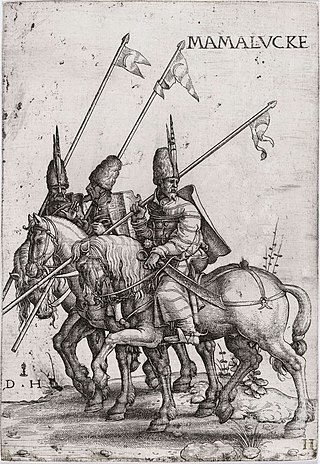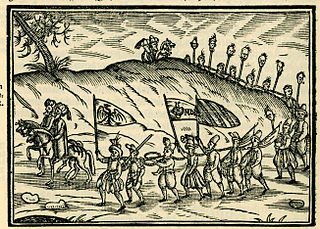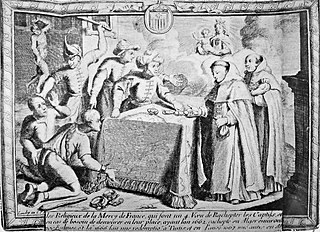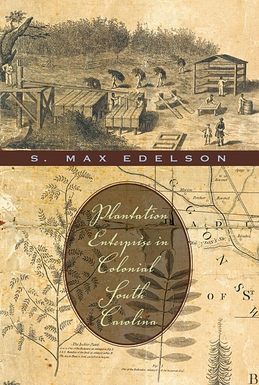
Slavery is the ownership of a person as property, especially in regards to their labor. Slavery typically involves compulsory work with the slave's location of work and residence dictated by the party that holds them in bondage. Enslavement is the placement of a person into slavery.

The Atlantic slave trade or transatlantic slave trade involved the transportation by slave traders of enslaved African people, mainly to the Americas. The outfitted European slave ships of the slave trade regularly used the triangular trade route and its Middle Passage, and existed from the 16th to the 19th centuries. The vast majority of those who were transported in the transatlantic slave trade were people from Central and West Africa who had been sold by West African slave traders to mainly Portuguese, British, Spanish, Dutch, and French slave traders. while others had been captured directly by the slave traders in coastal raids; European slave traders gathered and imprisoned the enslaved at forts on the African coast and then brought them to the Americas. Except for the Portuguese, European slave traders generally did not participate in the raids because life expectancy for Europeans in sub-Saharan Africa was less than one year during the period of the slave trade.

Mamluk is a term most commonly referring to non-Arab, ethnically diverse enslaved mercenaries, slave-soldiers, and freed slaves who were assigned high-ranking military and administrative duties, serving the ruling Arab and Ottoman dynasties in the Muslim world.

The Barbary pirates, Barbary corsairs, or Ottoman corsairs were mainly Muslim pirates and privateers who operated from the Barbary States. This area was known in Europe as the Barbary Coast, in reference to the Berbers. The main purpose of their attacks was to capture slaves for the Barbary slave trade. Slaves in Barbary could be of many ethnicities, and of many different religions, such as Christian, Jewish, or Muslim. Their predation extended throughout the Mediterranean, south along West Africa's Atlantic seaboard and into the North Atlantic as far north as Iceland, but they primarily operated in the western Mediterranean. In addition to seizing merchant ships, they engaged in razzias, raids on European coastal towns and villages, mainly in Italy, France, Spain, and Portugal, but also in the British Isles, the Netherlands, and Iceland.
Slavery, or the process of restricting peoples’ freedoms, was widespread within medieval Europe. Europe and the Mediterranean world during the medieval period (500–1500) were part of a highly interconnected network of slave trading. Throughout Europe, wartime captives were commonly forced into slavery. As European kingdoms transitioned to feudal societies, serfdom began to replace slavery as the main economic and agricultural engine. Throughout medieval Europe, the perspectives and societal roles of enslaved peoples differed greatly, from some being restricted to agricultural labor to others being positioned as trusted political advisors.

White slavery refers to the slavery of Europeans, whether by non-Europeans, or by other Europeans. Slaves of European origin were present in ancient Rome and the Ottoman Empire, and some Muslim dominions.

The history of slavery spans many cultures, nationalities, and religions from ancient times to the present day. Likewise, its victims have come from many different ethnicities and religious groups. The social, economic, and legal positions of enslaved people have differed vastly in different systems of slavery in different times and places.

Slave raiding is a military raid for the purpose of capturing people and bringing them from the raid area to serve as slaves. Once seen as a normal part of warfare, it is nowadays widely considered a crime. Slave raiding has occurred since antiquity. Some of the earliest surviving written records of slave raiding come from Sumer. Kidnapping and prisoners of war was the most common source of African slaves, although indentured servitude or punishment also resulted in slavery.

Slavery has historically been widespread in Africa. Systems of servitude and slavery were common in parts of Africa in ancient times, as they were in much of the rest of the ancient world. When the trans-Saharan slave trade, Indian Ocean slave trade and Atlantic slave trade began, many of the pre-existing local African slave systems began supplying captives for slave markets outside Africa. Slavery in contemporary Africa is still practiced despite it being illegal.

Slavery in Britain existed before the Roman occupation and until the 11th century, when the Norman conquest of England resulted in the gradual merger of the pre-conquest institution of slavery into serfdom, and all slaves were no longer recognised separately in English law or custom. By the middle of the 12th century, the institution of slavery as it had existed prior to the Norman conquest had fully disappeared, but other forms of unfree servitude continued for some centuries.

The Barbary slave trade involved slave markets in the Barbary States. European slaves were acquired by Barbary pirates in slave raids on ships and by raids on coastal towns from Italy to the Netherlands, Ireland and the southwest of Britain, as far north as Iceland and into the Eastern Mediterranean.

Slavery in Ethiopia existed for centuries, going as far back as 1495 BC and ending in 1942. There are also sources indicating the export of slaves from the Aksumite Empire. The practice formed an integral part of Ethiopian society. Slaves were traditionally drawn from the Nilotic groups inhabiting Ethiopia's southern hinterland as well as from the Oromos. War captives were another source of slaves, though the perception, treatment and duties of these prisoners was markedly different. Although religious law banned Christian slave masters from taking part in the slave trade, many Muslim Ethiopian slave traders took part in the Arab slave trade. Slaves usually served as concubines, bodyguards, servants and treasurers.

Slavery in Spain can be traced to the Phoenician and Roman eras. In the 9th century the Muslim Moorish rulers and local Jewish merchants traded in Spanish and Eastern European Christian slaves. Spain began to trade slaves in the 15th century and this trade reached its peak in the 16th century. The history of Spanish enslavement of Africans began with Portuguese captains Antão Gonçalves and Nuno Tristão in 1441. The first large group of African slaves, made up of 235 slaves, came with Lançarote de Freitas three years later. In 1462, Portuguese slave traders began to operate in Seville, Spain. During the 1470s, Spanish merchants began to trade large numbers of slaves. Slaves were auctioned at market at a cathedral, and subsequently were transported to cities all over Imperial Spain. This led to the spread of Moorish, African, and Christian slavery in Spain. By the 16th century, 7.4 percent of the population in Seville, Spain were slaves. Many historians have concluded that Renaissance and early-modern Spain had the highest amount of African slaves in Europe.

The history of slavery in the Muslim world began with institutions inherited from pre-Islamic Arabia. The practices of keeping slaves in the Muslim world nevertheless developed in radically different ways in different Muslim states based on a range of social-political factors, as well as the more immediate economic and logistical considerations of the Arab slave trade. As a general principle, Islam encouraged the manumission of Muslim slaves as a way of expiating sins, and many early converts to Islam, such as Bilal, were former slaves. However, slavery persisted as an institution in the Muslim world through to the modern era.
Ancillae (plural) or ancilla (singular) was the term for female house slaves in the Ancient Rome, as well as in Europe during the Middle Ages.

Concubinage in the Muslim world was the practice of Muslim men entering into intimate relationships without marriage, with enslaved women, though in rare, exceptional cases, sometimes with free women. If the concubine gave birth to a child, she attained a higher status known as umm walad.

Slavery in Egypt existed up until the early 20th century. It differed from the previous slavery in ancient Egypt, being managed in accordance with Islamic law from the conquest of the Caliphate in the 7th century until the practice stopped in the early 20th-century, having been gradually abolished in the late 19th century.
Red, White, and Black Make Blue: Indigo in the Fabric of Colonial South Carolina Life is a book written by Andrea Feeser and published by the University of Georgia Press in 2013.
The Other Slavery: The Uncovered Story of Indian Enslavement in America is a book about Native American slavery written by Andrés Reséndez and published by Houghton Mifflin Harcourt in 2016.

Plantation Enterprise in Colonial South Carolina is a book written by S. Max Edelson and published by Harvard University Press in 2006. The work is about plantations, slavery, and economics in colonial South Carolina.











